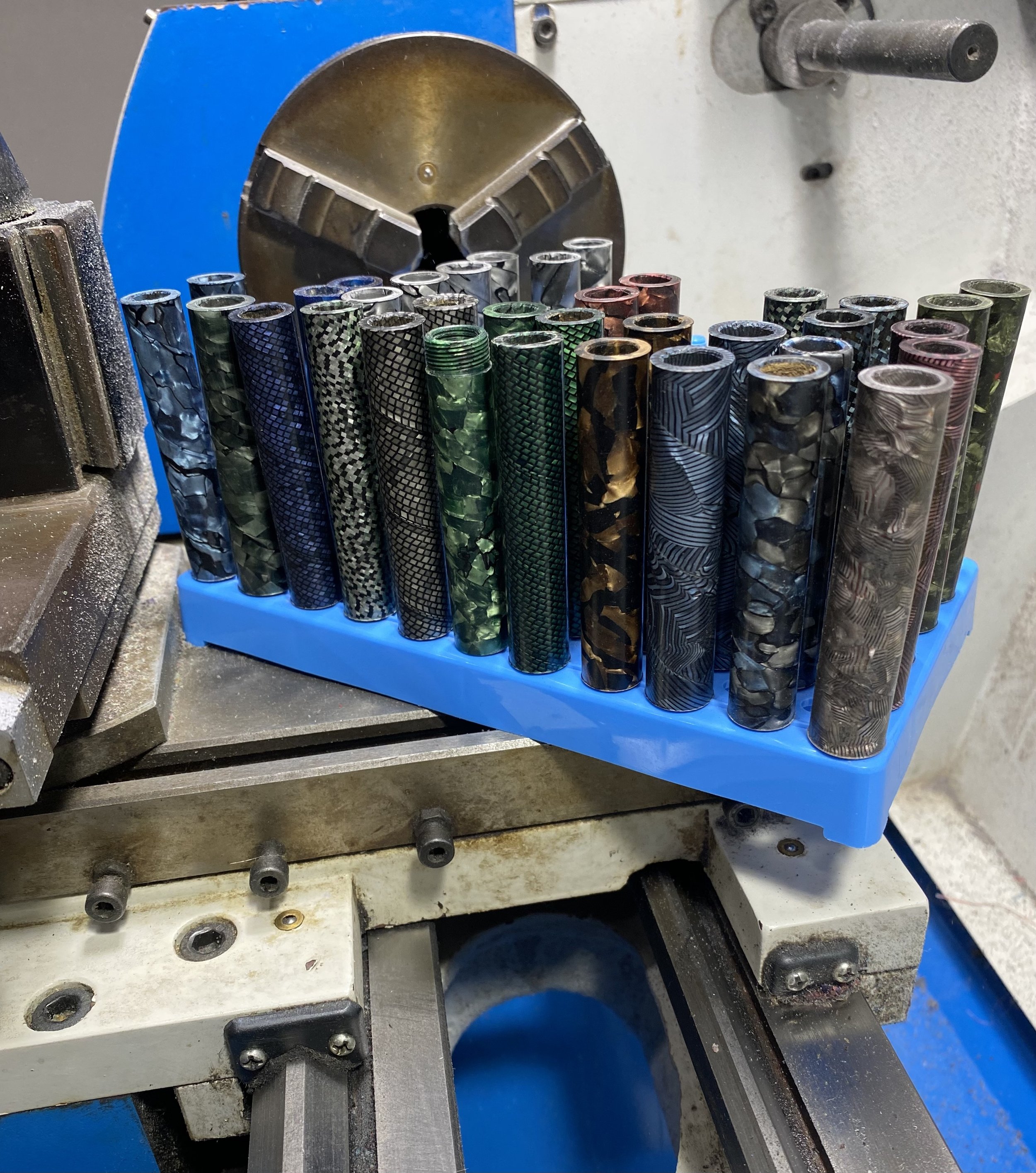A Rare Vintage
In the world of pen materials, there are so many options. In the modern pen making world, Alumilite, a urethane resin, reigns supreme. Alumilite is a strong, durable material that accepts pigments and dyes well and has almost endless design possibilities. I don’t want to take anything away from the outstanding alumalite materials or the talented makers, however I want to take a few moments to talk about my favorite pen making materials, cellulose based plastics.
Cellulose based plastics can be divided into several different groups. One of the first was Nitro Cellulose. Made by exposing cellulose to Nitric and Sulphuric Acids, creating a highly flammable film. It was used for guncotton (a replacement for gunpowder), mining explosives, and early photographic emulsions. Collodion was invented in the mid 19th century to use as a wound dressing and dried to a thin film. Several inventors experimented with nitro cellulose over the following decades.
Celluloid was a term applied to a newer plastic in 1872, created by John Wesley and Isiah Hyatt while experimenting with ways to create billiard balls. There was a movement to reduce the use of natural Ivory, and the new material was found to be useful in mimicking the grain structure of Ivory. The material was created by treating nitro cellulose with camphor , ethyl alcohol, and adding heat and pressure. After patents were filed for methods of thermoforming the material, it found many uses. Celluloid was used in early film stocks for motion pictures and must be stored in a particular way to prevent violent fires that are extremely difficult to extinguish. The film could self-ignite when exposed to high temperatures from the movie projector bulbs.
The properties of celluloid, especially that it can dry into thin films, that can be stacked together and pressed into a single material made it an outstanding material for fountain pens. There are patterns in materials, especially sheening and shimmering striations that can be produced through this layering of thin films that cannot be reproduced or are extremely difficult ro replicate through other processes (like Arco Celluloids). Due to the extreme flammability during production, and several disasters at factories, the production of celluloid in the US slowed the 1960s. Celluloid as a film stock was replaced by acetate in the 1950s.
Cellulose Acetate is produced by putting raw cellulose (from wood pulp or cotton fiber) through an acetylation process, using acting acid. Anyone who collects or uses the material will notice a vinegar smell from the off-gassing of the material over time., especially when stored in air tight containers. The Eastman Chemical Company was one of the largest producers of Cellulose Acetate.
Solid rods of different cellulose acetate patterns were produced, creating vivd and colorful designs that are seemingly impossible to recreate with modern resins. The Parker Vacumatic used an incredible stacked layer material that is well known as a durable and beautiful pen making material.
Another manufacturing method involved the cellulose acetate being laid out in thin layers of patters (chunky patters, long lines, small blocks, stacked lines etc…). These sheets were cut into thin strips and wrapped around tubes for curing. The diagonal lines created by wrapping the material around tubes can be seen in the poplar “Lizard Skin” tubes.
Vintage cellulose acetate rods can be used in modern pen making, but difficulties can arise due to the diameter of modern pens. Most of the tube stocks I have seen measure anywhere from 10mm-15mm in diameter. Many modern pen makers use larger body and cap diameters than vintage brands did, so these tubes require a different design or model in the product lineup. Other difficulties can include tapering, due to the thin walls of the tubes. Most makers that employ cellulose acetate tubes in their pens will use a modern material (alumalite, acrylic, ebonite) to make finials for the tubes.
These materials can be turned on a lathe, drilled out, threaded, sanded, and polished well. When thoroughly sanded, these materials will hold an incredibly brilliant finish. The biggest thing for makers to keep in mind is to limit heat in the process. Cellulose based material and heat never mix. Drills can cease to parts when using celluloids especially. Slow drilling is suggested when producing parts. If the materials ignite, it can be extremely dangerous to the maker and their shop.
It is also important not to use certain chemicals on the cellulose based materials. Acetone can reduce them to a jelly like substance, ill suited to producing writing instruments. Cyanoacrylate glues (super glue) and epoxies can be used on the materials generally.
Cellulose based materials can give a pen a natural feel. the surface of the pen feels more organic than other resins and plastics. Unfortunately, some of the materials can be stained by inks, and don’t make good grip sections or eye dropper fill pens.
There are quite a few pen makers that are producing beautiful pens using these vintage materials, as well as some modern production celluloids and cellulose acetates. Mainly produced in Europe and Asia, there are some good quality materials still in prduction. Some of the European pen companies have in-house celluloid production facilities.
Our Vintage Series pens include models that are produced using vintage celluloid and cellulose acetate bodies, mixed with both modern resins and ebonite (the VS1 and VS2). We strive to find pockets of these materials here and there and buy them when we find them if possible. Many of these patterns and materials were made nearly 100 years ago and will likely never be produced again. We are on a mission to not let these materials disappear from the pen work by keeping them alive in new designs and modern pens.






